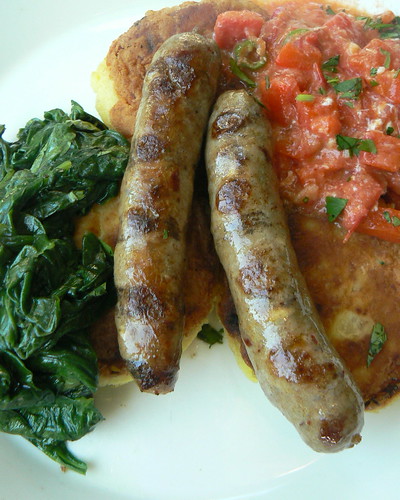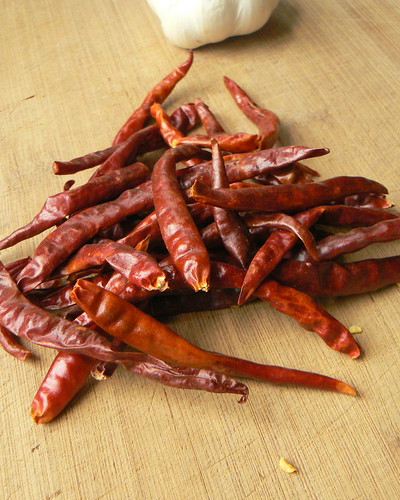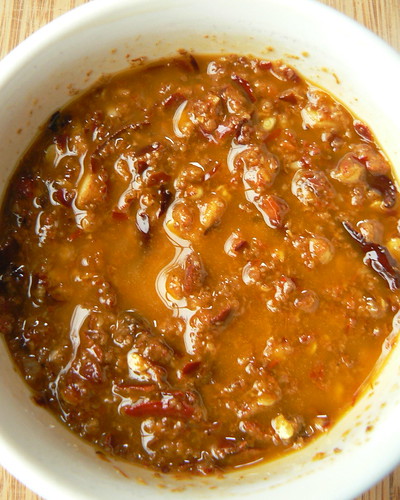
What's the best way to get inside your opponent's head? Find out what they eat. Merguez anyone? World Cup is on and the American's have a crucial test against Algeria tomorrow. So will the play be spicy? Let's find out.
I looked at a bunch of recipes and I concluded a good Merguez is just lamb and harissa. Harissa is a condiment of peppers garlic and spices used throughout Northern Africa (referred to by some as the Mahgreb).

For the Harissa I re-hydrated some dry red peppers, crushed some garlic,

And toasted some spices.
Everything went into the blender with some olive oil and some water and presto!

Harissa.
Here's the quantities:
10g (25-30) small dry red peppers
12g 2T whole coriander
12g 2tsp whole cumin
24g 4 cloves of garlic
1/2 cup 200 ml EV Olive Oil
Cold Water as needed.
The peppers. For better flavor you can toast them in a dry skillet until fragrant, or quickly blanch them in oil. Following either way, soak them in very hot tap water until soft about 15 minutes. Toast and grind the whole spices then throw everything into the blender. Only add cold water if you need to get things moving, up to 2T (30 ML)
Since I'm making this harissa for the sausage, I'm holing off on the salt. If you want to use it as a condiment, salt to taste (TT), my taste is about 1/2tsp (3g)
For the Sausage I use 2tsp (14g) of salt for 2 pounds (900g) of ground lamb. add all of the prepared harissa and 2T (12g) of fresh thyme. Mix well, add a little cold water to smooth it out.
Try to find some sheep's casing to stuff (pork casing are haraam), or make meatballs and call them keftas.
These sausages are spicy but not overly so, my kids ate them. You can serve them with couscous, but I also found a potato pancake (Makoud) recipe that was kinda fun. Sorry Algeria, I love your sausage but I'm going to have to root for the US on this World Cup.
Cheers.
References (all links to WorldCat, so you can find these books at a library near you)
The Great Book of Couscous, by Copland Marks
North African Cooking, by Hilaire Walden
The Soul of a New Cuisine, by Marcus Samuelsson
The Oxford Companion by Davidson
22 June, 2010
World Cup Algerian Merguez
Subscribe to:
Post Comments (Atom)


6 comments:
Merguez I've had are unbelievably fatty (and good). How fat is the ground lamb you used. Looks pretty nice. Might have to take a stab at these.
One last thought regarding the pepper rehydration/blender sequence. Once the peppers soften in the water, there are always little pieces that escape the blender/food processor blades. So, e.g. with ancho chiles, I process their hard dried shells in a coffee blade-grinder and use the fine powder in various applications. You think there's anything better gained by the hydration step?
Dear Dave:
I didn't use too much fat. The problem is that lamb is so darn expensive, one could feel obligated to use as much as the cut as possible to maximize yield. Also lamb overcooks very quickly, fat is a buffer for those who like to overcook their sausage. That said, merguez is a fun flavorful sausage, give it a try.
If you are satisfied with the flavor of the chiles run through the blade grinder, then don't complicate you life. I haven't done a side by side comparison freshly ground dried chiles vs. re-hydrated so I can't speak to the difference in taste.
So why do I re-hydrate? Tradition I guess. I watched Rick Bayless on TV toast his chiles in a dry skillet then run them through the blender after a soak. The preparation of chile paste is at least hundreds of years old. I started wonder what did people do before the Waring came around? I found my answer last year when I wrote about chorizo. Dried chiles were pounded in motar and pestles ( In Mexico the Metate). A little liquid and a paste would be made. Harissa is made the same way. Blanching in oil or dry toasting supercharges the flavors (just like toasting spices), I don't know why, I'm sure McGee has written extensively about it, but the difference is noticeable. While the harissa is meant to be chunky, I always strain my chile paste. Like a good stock in French cooking, chile paste is a foundation block upon which a lot of Mexican cooking is built, and as the chile crossed the globe and became integral to such diverse cuisines including North African, and Thai, the pounding process became a way of life too. Powder simply doesn't compute. Some say to get the 'true' flavor even a blender wont do, you gotta put it to the grindstone. We should so a test.
Thanks for writing
Looks great. While living in France I really fell in love with merguez. Before, during and after soccer matches there were always vendors selling merguez sandwiches on a baguette. A little dijon mustard and I was immediately in heaven! The large North-African population of France, had clearly made their culinary contributions to the masses!
I found a great place in Chicago, a butcher in Albany Park, that had the best I have found stateside. Unfortunately the owner, also a chef, closed up to open a restaurant down the road, Dawali Med. Kitchen on N. Kedzie. I haven't seen the merguez on the menu, but I am sure he'd throw some together with some notice!
I am surprised though by the lack of redness in your version. Everyone I have ever had was like Dave mentioned, high in fat, but also, quite red, before and after cooking! Keep up the great work Mac!
Dear Charc:
Thanks for checking in and congratulations on getting hitched, it looked like everyone had a good time down south.
The lamb I used came from the shoulder, fattier than the leg but not overly so. The harissa I made with dry chiles and their presence did not contribute much to the color. Take a look at the lamb and harissa in this pictureon Flickr. That's all my ingredients. In my reading I did find an incidence of sweet red pepper being used in Merguez, and that would punch up the color a bit. But I decided to put the red pepper in the side dish, Lehemiss.
Cheers.
Hello,
@Dave: Do you know anywhere in Columbus, OH where I can find ready made merguez sausages? I've been wanting to try these for a long time. Thanks.
Post a Comment